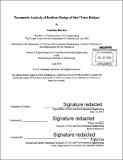Parametric analysis of resilient design of steel truss bridges
Author(s)
Borchers, Stephanie
DownloadFull printable version (9.505Mb)
Other Contributors
Massachusetts Institute of Technology. Department of Civil and Environmental Engineering.
Advisor
Pierre Ghisbain.
Terms of use
Metadata
Show full item recordAbstract
Designing structures to be resilient to extreme loads has become a topic of interest in recent years, which has been triggered by the progressive collapse of structures in the past. Structural failure due to the lack of resilient design has been particularly prevalent in bridges. The failures have been results of a variety of factors that the bridges have been subjected to. The objective of preventing the occurrence of future collapses has encouraged further research into the design of resilient structures. Two main methods to design for resilience have been implemented in this thesis. These methods include the incorporation of robustness or redundancy into the bridge design. Each method is advantageous over the other in certain circumstances. These methods are both based on linear static analysis procedures. A series of 2D truss bridge models with varying parameters have been analyzed for their performance in damaged states. The damage incurred by the bridges include the removal of a pier and the removal of bridge members. The results of this investigation conclude that the cost of designing a bridge to be resilient is relatively low in comparison to the overall cost of the bridge. Robust bridge designs are generally more effective for bridges with longer spans, whereas designs with redundancy are better suited for shorter spans. As the amount of structural damage that is incurred by a bridge increases, the more redundancy should be built into the structure. These results were shared by all three of the truss topologies that were explored.
Description
Thesis: M. Eng., Massachusetts Institute of Technology, Department of Civil and Environmental Engineering, 2015. Cataloged from PDF version of thesis. Includes bibliographical references (page 55).
Date issued
2015Department
Massachusetts Institute of Technology. Department of Civil and Environmental EngineeringPublisher
Massachusetts Institute of Technology
Keywords
Civil and Environmental Engineering.